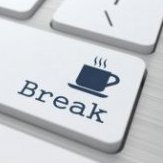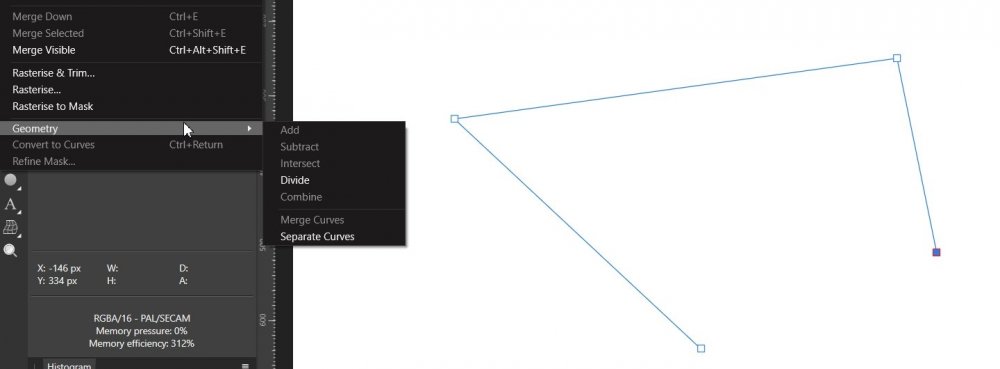-
Posts
407 -
Joined
Everything posted by hifred
-
I have now also tested Combine. That is still not the exactly same, insofar as all paths are initially drawn on separate layers and need to get reselected and combined by hand to put them one one layer. I usually prefer using the Lasso tool on a Cintiq over drawing vector selections anyway, but the 1.7 behaviour doesn't equal Photoshops path tool.
-
Oh – I see that is intended as boolean operations. First create various paths which all get their individual layers and then merge. I think what the OP wants is more how paths work in Photoshop. Any number of curves are automatically drawn as one unified object and may get converted to pixel-selections and masks.
-
Walt, while I have not tested this myself, this seems not at all unrealistic. Here's a Lightroom migration guide by a competitor.
- 18 replies
-
- lightroom
- affinity photo
-
(and 1 more)
Tagged with:
-

Feedback on Tool Group Cycling with Shift
hifred replied to hifred's topic in [ARCHIVE] Photo beta on Windows threads
This has been requested a couple of times but is not available yet. The reason of my post is an (optional) change of Grouped Tools behaviour which affects further assignment of Shift + Letters (Numbers). -
I'm traveling and away from my machine, but one thing came to my mind: From the various options available to hook up a protection from accidental tool change (by pressing Shift + tool-group shortcut) I believe one has now picked the one which forbids further Shift+Letter assignment, globally. I could well live with this loss for single commands, but I and likely many Photoshop-trained users would find painful if you for that reason no longer considered default Shift+Letter assignments for extremely helpful - albeit not yet implemented tool behaviour changes. What comes to my mind is Tool Flow control via keyboard. Photoshop uses exactly the same number key driven scheme as Affinity Photo to control tool opacity (4= 40%, typing 9 and 5 in quick succession gives 95% opacity). That works very well, but the same scheme in Photoshop is also available for Flow by pressing Shift and then typing letters. Gives fine grained control and requires minimal mental transfer. It would be great if you left the door open for new factory-default assignments of Shift+Letter tool behaviour shift, via Shift key.
-

Selection tool
hifred replied to Rudy Rogalsky's topic in Pre-V2 Archive of Affinity on Desktop Questions (macOS and Windows)
I fail seeing how this is couter-intuitive. What Photoshop does may not be strictly logical in a mathematical sense (as an exception to a rule is made) but it's very deliberately there and it prevents all users from error - that's what counts. Realistically, pretty much every Affinity-user will at least issue one failed selection attempt before discovering the wrong mode, this will sum up to very many needless clicks and decisions a year. It's your job to avoid these. Some users obviously even fail to decipher the modified cursor and need help, others get annoyed by such blatant weaknesses. -

Selection tool
hifred replied to Rudy Rogalsky's topic in Pre-V2 Archive of Affinity on Desktop Questions (macOS and Windows)
But that's a terrible and utterly needless trap MEB! A bug that would be trivial to turn off. Subtract from selection in no context makes sense without a pre-existing selection. That mode may therefore not be active, unless a state is established, which justifies it's existence. -

Selection tool
hifred replied to Rudy Rogalsky's topic in Pre-V2 Archive of Affinity on Desktop Questions (macOS and Windows)
I can't test this myself currently - but the actual question is why Rudy doesn't see the marching ants on newly created selections. If Hide Selection was involved: Is its implementation possibly sticky, so that it also affects completely new selections as well? If that was the case I'd consider this a bad usability bug. Hide Selection should only work on what's currently selected, new selection should turn the command off. -

Release date estimation
hifred replied to PilleniusMC's topic in [ARCHIVE] Photo beta on Windows threads
Thank you :o) -

Release date estimation
hifred replied to PilleniusMC's topic in [ARCHIVE] Photo beta on Windows threads
I just wanted to make you aware that you were likely barking up the wrong tree with your desire for this Zbrush Importer. Apart from that I can not resonate with your words – neither with your booming dislike for Adobe applications, nor with you rousing new love for Affinity products. I do differenciate between admirable achievements by Adobe programmers and UX designers and very very unfortunate licensing decisions taken by the management. Affinity is young and promising, but for now and for my usage profile I'm still far better off with Photoshop CS6. What I found interesting is, that you find Photoshop terribly bloated but have no issue with Zbrush. The latter – no doubt – is a highly interesting application, but it is just insanely feature crowded. Even regular users do need Youtube at times, as one simply can not keep in mind all the details of the myriads of different geometry creating principles Pixologic offers. -
It is painful to see how stubbornly you refuse good arguments. I should have been smarter.
-
Yes, it is. Therefore the most helpful answer is to tell him that this functionality isn't available and that it can't get substituted either. So I did. I will stop here, have nice day.
-
Or at least look at the attached gif: The sequence of actions here: Select RAWs for processing and use one of them to establish a global correction. It could be hundreds if you want. Select one of the images to perform a correction (I only increase blacks here) select all frames and click synchronize One typically may choose, what settings are transferred, which is more flexible than running a Macro On pressing "Done" selected modifications to the appearance are stored in a dataset associated with the RAW file (either sidecar or database). The RAWs remains unaltered, no images get output. But you can preview all manipulations in the DAM and get an indicator that the file was processed. All changes are re-editable, on single files or on any new selection of multiple files.
-
I think did read carefully enough. Batch developing (without exporting images) means nothing else but applying the same edits (quote) to any number of RAW files. How about trying this all out yourself (outside of Affinity) instead of just talking about it?
-
That, as stated before is often not desireable - and not what anyone in this thread asked for. I also gave you a sample of file writing with RAWs intact.
-
While this is not correct in the case of PSD (as it can embed all supported RAW files, along with their settings), I spoke of batch developing without saving to an image. Development yes, image none. Develop settings in that case are written to a little text based sidecar file, or alternatively to a database - that's why the process may run so fast.
-
Yeah maybe, but one very often doesn't even want to write an incompletely processed, static image, which no longer holds the original data set and editable settings. Batch processing is often understood as a common starting point for further individual, per frame corrections - on the RAW data and inside the RAW editor. Besides being extremely slow, any batch processing on RAWs currently is inevitable lossy with Affinity.
-

Release date estimation
hifred replied to PilleniusMC's topic in [ARCHIVE] Photo beta on Windows threads
Right, I had not watched the clip and mixed this one up with the official Pixologic Photoshop plugin which has the purpose I described. To me it looks as if you had to ask Joseph Drust for support rather - since he had tailored this Plugin towards a Photoshop CC pipeline: Although nothing in this script technically would require CC (Zbrush does all the work anyway) I can't even use it in PS CS6. This very likely only has to do with some hard coded file paths inside his plug-in. All what's required is pushing a supported third party file to Affinity Photo, to trigger a file open, possibly to display some dialogs and to have it listen to updates in this external file. Is that really not possible yet, with Affinity Photo? At any rate your assumption that Adobe is silly and sleeping seems quite odd in this context: It was actually Adobe who, many years ago made their app open enough for external scripters to support a tiny fraction of Photoshops userbase by making the import of layered files from Zbrush more convenient. -

Release date estimation
hifred replied to PilleniusMC's topic in [ARCHIVE] Photo beta on Windows threads
I like Zbrush too - but for this particular task you might really check out 3DCoat. Not only do they have powerful native 3D painting tools, you can also assign any image editor that reads and writes layered psd's as an external editor for either unwrapped UVs or projection painting, as available in the Zbrush plugin. I have not yet tested Affinity Photo as the external editor, but I think it should work. -
Thanks for the clarification @walt.farell. I had assumed, that the OP wanted to do what one most typically would expect from batch processing RAWs. That's certainly not bringing RAWs unprocessed into the Layer based workspace (by circumventing the RAW processor) as suggested by @v_kyr. I frankly did not even consider this option - for me batch processing RAWs would mean working on the RAW data. Another often expected characteristics of batch processing RAWs is, that the same settings may get transferred to hundreds of files - within seconds. That's entirely impossible as well, with Affinity Photo.
-
This is false info. There's no batch processing for RAW files in Affinity Photo (no Macro support in the Develop Persona). Using presets would mean having to open files manually, one by one - which is (by far) the most time-consuming part.
-
I do remember and agree with every word - I'm just not sure how effective such forum feedback really is. Is there someone who looks for repeating feedback pattern and picks up ideas also outside the feature request forum and puts them onto a list? We don't know. Just a few days ago I commented in a thread which had a well chosen name and already went on for more than forum page. I happened to get an answer by a staff member which made clear to me that the underlying issue wasn't understood yet. In that case, with my answer I was able to sell the idea, but I tend to think that such is rather the exception, but the rule.
-
Well, that's the whole purpose of making this layer/ mask preview size editable in PS, AI, IN. If you work with very many layers regularly you can decrease their size - if not - by all means make them big. It should be the user who decides what too much scrolling means. Good Layer filters and Search help too. Right now the small and hard coded square thumbnails are top reasons why I find the Layer Panel difficult to read - already with just a few layers.





